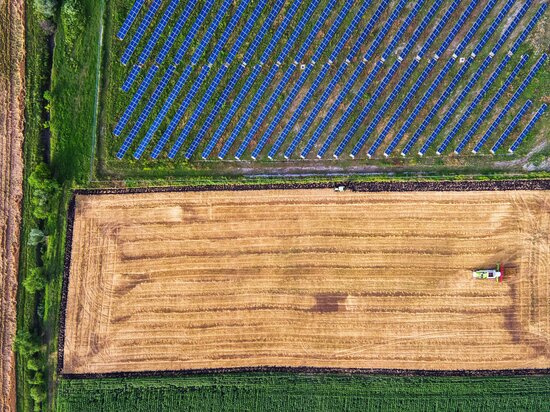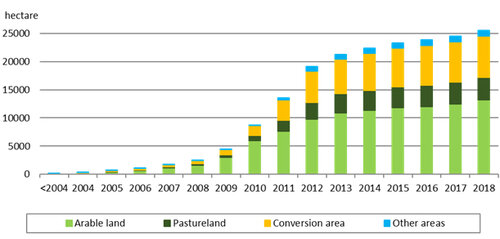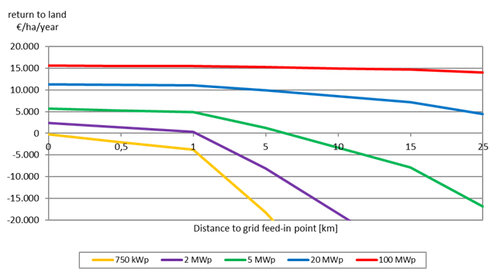Expertise
PV electricity from the field: In harmony with or in competition with agriculture?
Jonas Böhm, Thomas de Witte, Christoph Pahmeyer, Alexander Gocht, Sebastian Neuenfeldt | 08.05.2023
Ground-mounted PV systems are expected to become an important part of the future energy system - but with what impact on agriculture?
The expansion of renewable energies is increasingly moving into the political and social focus. In addition to wind energy, photovoltaic systems on agricultural land will play a major role in the future. The main reason for this is the comparatively favourable electricity production costs compared to rooftop systems.
This raises the question of how the demand for land for PV systems will develop, what this means for agriculture and which approaches can be used to avoid possible competing uses. The Thünen Institute is investigating these questions in the project Photovoltaic systems on agricultural land.
Current land use
There is increasing discussion about possible competition between PV and agriculture. In order to objectify the discussion, the Thünen Institute of Farm Economics has recorded and analysed the status quo.
First of all, the current number of installations was analysed. It showed that in 2018, around 25,500 ha were used for ground-mounted PV systems. Of this, a large part was arable land, but conversion areas, i.e. old industrial or military land, were also used (see Figure). Overall, in 2018, ground-mounted PV systems were already installed on about 0.1 % of the previously agriculturally used land. As less and less conversion land is available, in recent years mainly arable land has been used for the installation of ground-mounted PV systems. Further information can be found in an article in the Zeitschrift für Energiewirtschaft.
Privileged areas along motorways and railways
In order to accelerate the expansion of ground-mounted PV systems, the German Act for the Immediate Improvement of the Framework Conditions for Renewable Energies in Urban Planning Law came into force on 11 January 2023 (BGBl 2023 I Nr. 6). It is now possible to realise ground-mounted PV systems at a distance of 200, around motorways and double-track railway lines through privileged use without adjustments to the development plan. About 450,000 ha of previously agriculturally used land are affected by this privilege. Of this, about 70 % is arable land, 14 % is permanent grassland and another 14 % is other land such as permanent crops. Depending on the size of the system and the area occupied by PV modules, the electricity yield that can be generated varies. In an interactive Notebook from Observable, the Thünen Institute has compiled an overview of areas along motorways and railway lines that are suitable for open-space PV systems.
Future land requirements
The question arises as to how much agricultural land - in addition to the land already in use - will be needed in the future given the planned expansion targets? The Thünen Institute of Farm Economics has made an estimate of this. Based on the future demand for PV power in a transformed energy system, the share of PV ground-mounted systems in PV power and the specific land use, a demand of approx. 2 % of the currently agriculturally used area is assumed. Depending on the scenario, the demand can also be higher, up to a maximum of 4 %. In order to estimate this value, it is helpful to bear in mind that 9 % of agricultural land is already used for electricity and heat generation from biogas. Details of the analysis can be found in Thünen Working Paper 204.
Even if, in an extreme scenario, it is assumed that Germany's entire energy demand is covered by wind turbines and PV, the land required is thus significantly less than the current amount of land for energy crops. The dossier Photovoltaics on agricultural land explains in detail how energy supply from the field can work without endangering the security of food supply.
Comparison of land energy yields
Due to the increasing demands on land for food and energy production as well as the provision of biodiversity services, it will become increasingly important in the future to use land as efficiently as possible. Against this background, the Thünen Institute of Farm Economics has analysed the energy yields of different renewable energies for the production of electricity, heat and mobility. The results show that in comparison to the cultivation of energy crops with wind turbines and ground-mounted PV systems, depending on the type of energy, 24 to 80 times the amount of energy can be provided per hectare of land. The video "Energy from the field - is it worth it?" explains the differences. The calculation and data basis for the video can be found here.
Economic viability and general conditions
How the future expansion of ground-mounted PV systems will develop depends strongly on the legal framework and the economic viability of ground-mounted PV systems. Profitability analyses show that the distance to the grid feed-in point is decisive for the economic realisation of the PV systems (see Figure). Another important parameter for the profitability of the system is the size of the system. Currently, it is mainly systems with a size of about 7 hectares or more that are profitable. The economic utilisation of the land, expressed in terms of land rent, is significantly higher than with traditional agricultural use. This creates a considerable incentive to build ground-mounted PV systems on agricultural land. For land owners, it is thus likely to be more profitable to lease their land to PV system operators rather than to agricultural enterprises.
Further information on the current framework conditions and the economic viability of ground-mounted PV systems can be found here.
Reducing land use competition with Agri-PV?
One idea to reduce possible land competition is so-called Agri-PV systems. Here, agricultural use and PV power generation are combined on the same area. This can be realised with different concepts (see pictures). In future, the Thünen Institute of Farm Economics will investigate whether Agri-PV is an economically viable option, which concepts are currently the most promising and how they can be integrated into farms.
A Thünen podcast on the advantages and disadvantages of Agri-PV can be found here.









